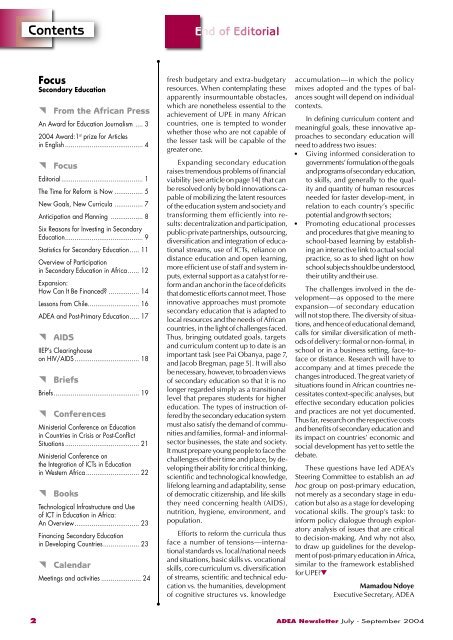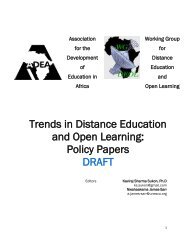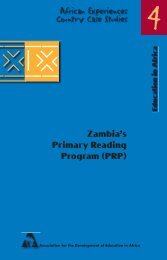Newsletter Vol.16 No.3 - ADEA
Newsletter Vol.16 No.3 - ADEA
Newsletter Vol.16 No.3 - ADEA
You also want an ePaper? Increase the reach of your titles
YUMPU automatically turns print PDFs into web optimized ePapers that Google loves.
FocusSecondary Education From the African PressAn Award for Education Journalism .... 32004 Award:1 st prize for Articlesin English ......................................... 4 FocusEditorial........................................... 1The Time for Reform is Now ............... 5New Goals, New Curricula ............... 7Anticipation and Planning ................. 8Six Reasons for Investing in SecondaryEducation......................................... 9Statistics for Secondary Education..... 11Overview of Participationin Secondary Education in Africa...... 12Expansion:How Can It Be Financed? ................ 14Lessons from Chile........................... 16<strong>ADEA</strong> and Post-Primary Education..... 17 AIDSIIEP’s Clearinghouseon HIV/AIDS .................................. 18 BriefsBriefs............................................. 19 ConferencesMinisterial Conference on Educationin Countries in Crisis or Post-ConflictSituations ....................................... 21Ministerial Conference onthe Integration of ICTs in Educationin Western Africa ............................ 22 BooksTechnological Infrastructure and Useof ICT in Education in Africa:An Overview.................................. 23Financing Secondary Educationin Developing Countries................... 23 CalendarMeetings and activities ..................... 24fresh budgetary and extra-budgetaryresources. When contemplating theseapparently insurmountable obstacles,which are nonetheless essential to theachievement of UPE in many Africancountries, one is tempted to wonderwhether those who are not capable ofthe lesser task will be capable of thegreater one.Expanding secondary educationraises tremendous problems of financialviability [see article on page 14] that canbe resolved only by bold innovations capableof mobilizing the latent resourcesof the education system and society andtransforming them efficiently into results:decentralization and participation,public-private partnerships, outsourcing,diversification and integration of educationalstreams, use of ICTs, reliance ondistance education and open learning,more efficient use of staff and system inputs,external support as a catalyst for reformand an anchor in the face of deficitsthat domestic efforts cannot meet. Thoseinnovative approaches must promotesecondary education that is adapted tolocal resources and the needs of Africancountries, in the light of challenges faced.Thus, bringing outdated goals, targetsand curriculum content up to date is animportant task [see Pai Obanya, page 7,and Jacob Bregman, page 5]. It will alsobe necessary, however, to broaden viewsof secondary education so that it is nolonger regarded simply as a transitionallevel that prepares students for highereducation. The types of instruction offeredby the secondary education systemmust also satisfy the demand of communitiesand families, formal- and informalsectorbusinesses, the state and society.It must prepare young people to face thechallenges of their time and place, by developingtheir ability for critical thinking,scientific and technological knowledge,lifelong learning and adaptability, senseof democratic citizenship, and life skillsthey need concerning health (AIDS),nutrition, hygiene, environment, andpopulation.Efforts to reform the curricula thusface a number of tensions—internationalstandards vs. local/national needsand situations, basic skills vs. vocationalskills, core curriculum vs. diversificationof streams, scientific and technical educationvs. the humanities, developmentof cognitive structures vs. knowledgeaccumulation—in which the policymixes adopted and the types of balancessought will depend on individualcontexts.In defining curriculum content andmeaningful goals, these innovative approachesto secondary education willneed to address two issues:• Giving informed consideration togovernments’ formulation of the goalsand programs of secondary education,to skills, and generally to the qualityand quantity of human resourcesneeded for faster develop-ment, inrelation to each country’s specificpotential and growth sectors;• Promoting educational processesand procedures that give meaning toschool-based learning by establishingan interactive link to actual socialpractice, so as to shed light on howschool subjects should be understood,their utility and their use.The challenges involved in the development—asopposed to the mereexpansion—of secondary educationwill not stop there. The diversity of situations,and hence of educational demand,calls for similar diversification of methodsof delivery: formal or non-formal, inschool or in a business setting, face-tofaceor distance. Research will have toaccompany and at times precede thechanges introduced. The great variety ofsituations found in African countries necessitatescontext-specific analyses, buteffective secondary education policiesand practices are not yet documented.Thus far, research on the respective costsand benefits of secondary education andits impact on countries’ economic andsocial development has yet to settle thedebate.These questions have led <strong>ADEA</strong>’sSteering Committee to establish an adhoc group on post-primary education,not merely as a secondary stage in educationbut also as a stage for developingvocational skills. The group’s task: toinform policy dialogue through exploratoryanalysis of issues that are criticalto decision-making. And why not also,to draw up guidelines for the developmentof post-primary education in Africa,similar to the framework establishedfor UPE?▼Mamadou NdoyeExecutive Secretary, <strong>ADEA</strong>2 <strong>ADEA</strong> <strong>Newsletter</strong> July - September 2004
















